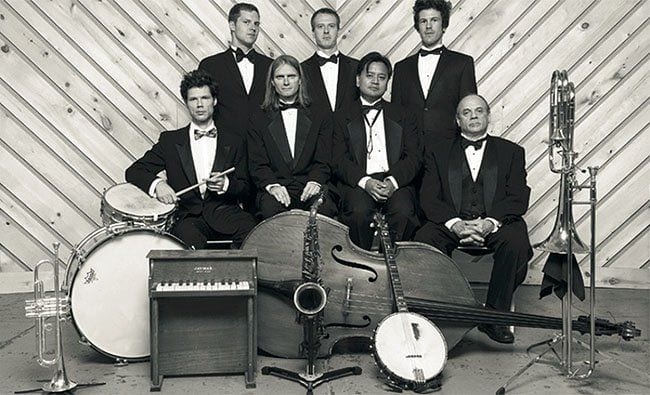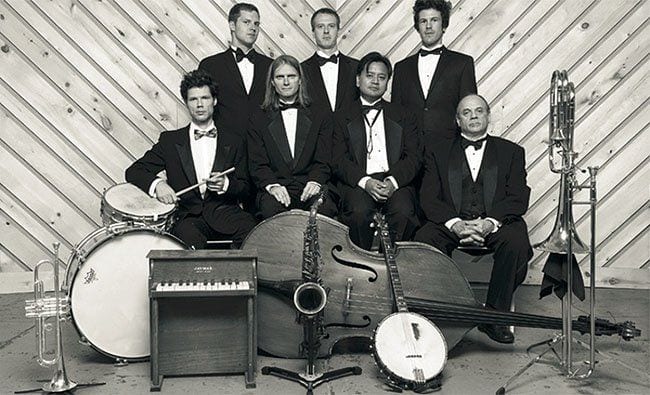
Mostly Other People Do the Killing never fail to thrill, even when they’re not doing something wholly new and shocking. “MOTDTK” started life as a piano-less quartet a decade ago and have produced about one recording her year, mixing post-bop acumen with humor and expressive freedom, often hopping from concept to concept. Three years ago, they offended a huge portion of the jazz world back when they recreated Miles Davis’s Kind of Blue, note for note, in an attempt to ask complicated questions about what makes art replicable, what makes artistic expression unique, and how jazz makes those questions particularly knotty. I’d never seen a wider range of different musicians more perturbed by something. The band, all great players and super-smart guys, were performing riveting postmodern experiment.
Blue was the band’s last recording with trumpet magician Peter Evans. Since then, pianist Ron Stabinsky has become a regular, after he first appeared on the band’s previous septet recording, Red Hot from 2014 (also with trombonist David Taylor, and string king Brandon Seabrook). There, the band was fooling around with jazz from the era of Jelly Roll Morton and early Ellington. The new disc is their sequel to that experiment, subbing in Steve Bernstein (a jazz-convention-ignorer from an older generation) on trumpet.
Loafer’s Hollow feels like Red Hot, Part Two, but it offers riches anew. MOPDTK is again attacking the early years of jazz — not just pre-bebop but often pre-swing. Brandon Seabrooks plays a mean banjo on most of these tracks, and between his twangy additions and some old-school hi-hat hi-jinks by drummer Kevin Shea, there is a set of old-old-school affectations here that put your ears back into the 1920s and 1930s. The horn players also offer period shtick: just dig the tailgate-styled trombone on “Bloomsburg” or, on that same tune, the way Steve Bernstein cackles and scampers on trumpet, employing the kind of expressive playing that would have seemed corny or unserious a couple of decades later.
But MOPDTK has always been an ensemble with a postmodern sensibility, mixing old with new, high with low, displacing history into a mixture that is somehow both silly and deadly serious. This is most certainly why composer and bassist Moppa Elliot has dedicated five of these tunes to authors, several of whom (Pynchon, Vonnegut, and Wallace) are paragons of the po-mo. MOPDTK could provide the soundtrack to hypothetical movies of Mason and Dixon and Infinite Jest, and here the band has started in on the task.
The fun and brio in Loafer’s Hollow are there from the very beginning. “Hi-Nella” seems like pure period gallivanting for just about all of the first two minutes… until a blowzy and bold cadenza by Bernstein on slide trumpet fills the next 90 seconds with wit and surprise, played in a harmonically freestyle that no New Orleans trumpeter would have pulled off.
“Honey Hole” comes out like a treat from the early swing era, setting up a sumptuous tenor saxophone solo from Jon Irabagon that begins firmly in the tradition and breaks free of gravity by bits only to find its way back into orbit. Taylor’s solo is all crazy intervals, bounced around the ensemble’s accompaniment. The whole thing is jazz with a smile.
“Kilgore”, dedicated of course to Kurt Vonnegut, begins with a modern sound and evolves toward the tradition. Taylor uses a mute to whisper and conspire on trombone, picking up rhythmic groove along the way. Then, before too much momentum catches, MOPDTK shuts down and starts over with Irabagon conjuring a wild solo soprano saxophone statement that uses squeaks and whistle effects. Then, booooom!, the ensemble plays like it’s 1925 for 20 seconds before Stabinsky takes over with a stride-piano-on-acid solo that travels from Tatum to Cecil Taylor which leads to a traditional ending. Is the effect like the time travel of Kurt’s Billy Pilgrim? You bet.
“Mason and Dixon”, following suit, is reasonably Pynchon-esque. Stabinsky’s solo opening is dark and impressionistic, even ominous (“A screaming comes across the sky. It has happened before but there is nothing to compare it to now.”), but soon enough the tune is making with the jokes, including as just one example the rave-up section from “Mercy, Mercy, Mercy”, followed by the first avant-garde banjo solo I’ve ever heard. Benjamin Franklin, who improvises some crazy “jazz” on his Glass Armonica in the novel, would no doubt approve.
Cormac McCarthy gets his tribute in “Meridian”, another tune that borrows liberally from wildly different genres. The opening phrase evokes “Makin’ Whoopee” then steers into a unique melody, setting up a charming, Lester Bowie-esque trumpet solo from Bernstein. Before you know it, though, the tune moves into the vibe and harmonic pattern from the chorus to the 1983 hit “If This Is It” by Huey Lewis and the News. And, you know what? That little slice of pop, given a brass band treatment, is heaven!
The fun pops up in places where you least expect it too. Stabinsky’s piano solo in “Glen Riddle” quotes from the I Dream of Jeannie theme song amidst a free, wonderful ramble. The members of the septet bat ideas back and forth like the game afoot was beer pong. Does it all get you a bit tipsy. It does me.
Are Elliot and his comrades asking another big philosophical question here? Is the entire Mostly Other People Do the Killing enterprise a humorous aside to jazz rather than the real thing? I believe the answers are: no and no.
MOPDTK works sincerely and authentically in a celebrated tradition. Like Lester Bowie’s Brass Fantasy, the band uses a playful spirit to tangle history and progress into a joyful experience. Not every one of the recordings raises existential questions, but they all channel expert musicianship and genuine creativity into a self-examination of the genre. There is both heart and soul in the music, not just a bunch of references and gags. Irabagon alone makes the recordings significant, and the addition of these two brass players deepens the gravity of the music. By demonstrating yet again that “free” playing and older styles swim together beautifully, the band is part of an important 21st century movement. And, with his authorial dedications on this record, Elliot is acknowledging that jazz is part of a larger conversation in the arts.
I hope that Mostly Other People Do the Killing keeps making music and keeps us laughing, questioning, and feeling stuff. That’s what art does.


![Call for Papers: All Things Reconsidered [MUSIC] May-August 2024](https://www.popmatters.com/wp-content/uploads/2024/04/all-things-reconsidered-call-music-may-2024-720x380.jpg)



